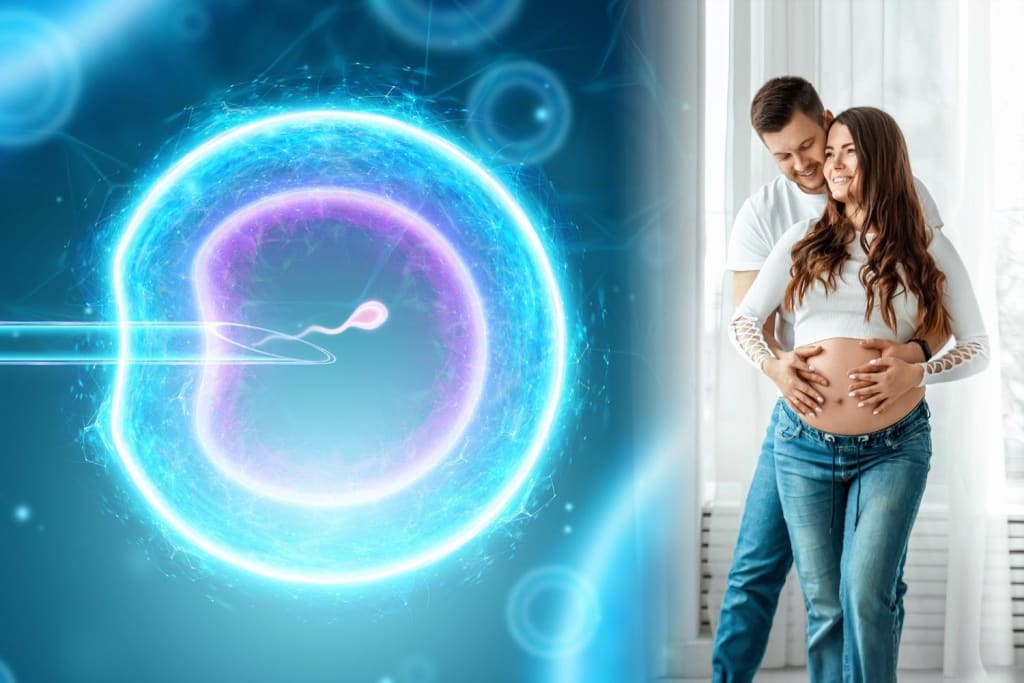Social Egg Freezing – race against time!
Social, personal, educational and financial pressures often lead women to delay starting a family until the late thirties, by which time the chance of getting pregnant is compromised by low fecundity rates and an increased risk of miscarriage if they become pregnant.

Human eggs have a definite decline in quality as well as quantity after 30 years of a woman’s age, which rapidly declines after the age of 35. Social egg freezing is seen as an insurance against age related fertility decline.
Fig. 1 - Ref. National Summary Report- SART 2017
Ovarian Reserve:
Ovarian Reserve (OR) is used to describe a woman’s reproductive potential by means of the quality and quantity of the oocytes her ovaries possess. (2) Ovarian Reserve can be roughly assessed through tests which are hormonal and through sonographic imaging of ovaries.
Whilst Diminished Ovarian Reserve (DOR), DOR is defined as a decrease in the number of quality & quantity of oocytes. It is used to describe women of reproductive age with regular cycles mostly ovulatory, whose response to stimulation or fecundity is reduced compared to women of similar age. It is distinct from menopause or premature ovarian insufficiency. It is affected by age, genetics, surgical, cancer therapy and environmental factors. DOR is associated with poor ovarian response to ovarian stimulation, higher cycle cancellation rates and lower pregnancy rates during In Vitro Fertilization (IVF) (3).
Nearly 10% of women undergo accelerated oocyte pool depletion, which leads to sub fertility and infertility early in life, and with the present scenario of many women delaying childbearing, this issue may be of concern since it means many more women will end up with a diminished ovarian reserve (1). In many developed countries, 25% women do not attempt pregnancy till 35 years of age (4) which is also being seen very commonly in metro cities like Mumbai. It has been concluded that the awareness of DOR would lead women to modify their reproductive decisions (5) and make alternative decisions. Women may become more well–versed with their reproductive lifespan and menopausal timing if offered ovarian reserve tests. Single women or married women wanting to delay their pregnancies, may especially benefit by freezing their eggs at an appropriate age, so as to have better pregnancy rates than they would if they tried at a later date.
Table 2.
Causes of Diminished Ovarian Reserve
Idiopathic
Chemotherapy
Radiotherapy
Genetic mutations like FMR
Smoking
Ovarian surgeries
Autoimmune
Mumps
Galactosemia
Tubal surgery
A woman’s chronological age is not the only determinant of ovarian reserve. Studies have demonstrated an association between the cause of Diminished Ovarian Reserve (DOR) and IVF outcome.
Other causes of DOR include iatrogenic ovarian surgeries, uterine artery ligation, laparoscopic salpingectomy, genetic diseases (Turner’s, Fragile X, FSH receptor and Inhibin B mutations), enzyme defects, mumps oophorihis, autoimmunity (Polyglandular syndrome, lymphocytic oophoritis, Addison’s disease, Hashimoto thyroiditis, celiac disease) and metabolic (Galactosemia) (6). Chemotherapy depletes primordial follicles in a dose and drug-dependent manner. Risk of toxicity during chemotherapy increases with age. Similarly, radiation affects ovaries depending on the dose, field and age of the patient (7). Idiopathic diminished ovarian reserve involves accelerated oocyte apoptosis. According to Barkers hypothesis, maternal endocrine disturbance during in utero life may result in DOR in the female fetus (8).
Table 3
Pregnancy rate with fresh v/s vitrified oocytes
Fresh Cycles Vitrified cycles P Value
No. of cycles 128 425
Preg. Rate (%) 39.8 49.6 0.001
Miscarriage rate (%) 9.4 12.8 0.679
Implantation rate (%) 37.2 43.0 <0.001
Ref. Braga et.al, Fertility & Sterility Vol. 106, No.3, Sept 1, 2016
Conclusion:
The pregnancy and implantation rates were significantly lower in the cycles with fresh oocytes.
The Process
Scientists have been using egg-freezing from the late 1990s for fertility preservation of cancer patients. Egg freezing is a process that involves the stimulation of the ovaries with hormonal injections to grow as many eggs as possible, followed by vaginal retrieval with subsequent freezing and storage of a woman’s viable eggs in an egg bank. Later, whenever the woman plans to get pregnant, the eggs are thawed (unfozen), fertilized with her partner’s sperms and transferred to her womb as embryos, using in-vitro fertilization (IVF) techniques.
Table 1.
Preliminary Live Birth Per New Patient
<35 35-37 38-40 41-42 >42
No. of patients 33026 16403 13371 5817 4071
Singleton births / cycle start 47.8 % 38.4 % 26.0 % 13.5 % 4.5%
Live Births 54.8% 43.5% 29.2% 14.8 % 4.9%
Singleton
(% of live births)
87.2% 88.3% 89.1% 91.2% 92.0%
Twins
(% of live births)
12.6% 11.5% 10.5% 8.7% 8.0%
Triplets or more
% of live births
0.3% 0.2% 0.4% 0.1% 0%
Term 82.7% 83.5% 83.1% 83.1% 80.6%
Pre-term 14.2% 13.6% 14.1% 14.1% 15.4%
Very pre-term 3.1% 3.0% 2.8% 2.8% 4.0%
Ref. National Summary Report- SART 2017
Efficacy
Egg freezing can be achieved using slow-freezing or vitrification (ultra rapid-freezing). Vitrification is currently recommended as it increases egg survival when thawed and gives improved pregnancy rates. The survival rate of eggs after vitrification and thawing is 90%–97%, the fertilization rate is 71%–79% and the womb implantation rate is 17%–41%. (9) The chances of becoming pregnant after implantation are roughly 30-60%, depending on the age at the time of egg freezing. Importantly, the older the woman is at the time of egg freezing, the lower the likelihood that she will have a baby in the future. (10)
Health Risks
The health risks of Egg Freezing are minimal, which include those occurring from ovarian stimulation and egg retrieval under anesthesia. There is a rare possibility of ovarian hyperstimulation syndrome in which mild abdominal pain, bloating, nausea, vomiting and diarrhea can occur with varying severity due to too many eggs growing. (11)
The egg-to-baby rate is around 6.5% ie. the chance that a frozen egg from one fertile young woman will result in one baby is therefore one in 16, but as many eggs almost 15 eggs may be retrieved in one egg freezing cycle, there remains a ‘good’ chance to have a baby with young eggs at a later age, considering the other option of not having a baby at all! (12)
Management
The management of DOR can be a frustrating experience both for the patient and her physician. The strategies used are all aimed at getting a higher oocyte yield. Various treatment regimens have been designed to manage the patients with diminished ovarian reserve and include high dose of gonadotropins, natural and modified natural cycles, estrogen priming, supplementation with LH, luteal antagonists and letrozole co-treatment use of adjuncts like androgens, growth hormone, melatonin and aspirin, oocyte donation and assisted hatching.
Oocyte donation
Egg donation may be the last efficient resort to offer hope to patients with diminished ovarian reserve and poor response. Though the pregnancy rates in women who use egg donation are as good as in young women, the decision to receive donated eggs is often difficult to make. Moreover, the facilities for egg donation, the acceptability and adequate counseling may not be available worldwide.
Table
Fresh Donor Eggs
Age of woman
All ages
No. of recipient cycle starts 3324
Singleton births per cycle start 40.3%
Live births 48.9%
Singleton
(% of live births)
82.4%
Twins
(% of live births)
17.3%
Triplets or more
(% of live births)
0.3%
Ref. National Summary Report- SART 2017
The Future
The newer yet-to-be established approaches in poor responders include ovarian transplantation, mitochondrial transfer and stem cell based neo-oogenesis [13,14].
Some new experiments have tried to restore the possibility of fertility in women with depleted ovarian reserve. Germ line stem cells have been isolated in adult mouse ovaries, following which several studies have attempted to isolate mitotic germ cells in adult human ovaries [15].
Virant – Klun et al. [15] tried to isolate the ovarian stem cells (OSCs) from the ovarian surface epithelium (OSE) in women with no naturally present oocytes and follicles. OSE scraping isolated small round cells, 2–4 μm in diameters which were cultured and some oocyte like cells developed and reached 20 μm diameter and were termed “embryonic-like stem cells of the adult”. And later these oocyte – like cells underwent parthenogenetic activation to form blastocyst – like structures [15]. Research is being carried out to try and develop of artificial gametes from diploid somatic cells. The problems being faced are the inability of the somatic cells to reduce their chromosomes with the necessary efficacy of a germ cell. During this process there is high incidence of chromosomal abnormalities resulting from non- disjunction. More research is needed to determine whether these approaches are a realistic paradigm in the management of women with no follicles / eggs.
Conclusions
There have been a multitude of studies on diminished ovarian reserve and poor ovarian response, yet we are to reach a consensus and conclusion about the correct definition and management. We believe that detailed patient counseling and the most appropriate ovarian stimulation are the keys to optimize reproductive outcomes in such patients. Women with DOR should be appropriately counseled to undergo a rather- aggressive approach to achieve pregnancy before it is too late. On the other hand as a preventive measure, if women who are not planning a pregnancy within the next couple of years, should be counseled to freeze their eggs.
References:
Rasool, Shah, Fertility with early reduction of ovarian reserve; the last straw that breaks the Camel’s back, Fertility Research and Practice (2017) 3:15
Practice Committee of the American Society for Reproductive Medicine, Testing and interpreting measures of ovarian reserve a committee opinion. Fertil Steril 2015; (103-17.
Yun BH, Kim G, Seo SK, et al. vitro fertilization outcome in women with diminished ovarian reserve. Obstet Gynecol Sci. 2017;60 (1):46–52
Schmidt L, Sobotka T, Bentzen JG, Nyboe Anderson A. ESHRE Reproduction and Society.
Azhar E, Seifer DB, Melzer K, Ahmed A, Weedon J, Minkoff H. Knowledge of ovarian
Nelson LM. Primary ovarian insufficiency. New Eng J of Med. 2009;360:606–14.
Beerendonk CC, Braat DD. Present and future options for the preservation of fertility in female adolescents with cancer. Endocr Dev. 2005;8:166–75.
Morita Y, Tilly JL. Oocyte apoptosis: like sand through an hour glass. Dev Biol. 1999;213:1–17.
Angel Petropanagos et.al. Social egg freezing, Canadian Medical Association Journal (CMAJ) June 2015
H. Golduran et. al. Predicting the likelihood of live birth rate, April 2017
Pratap Kumar et. al. OHSS, J.Hum. Reprod. Sci. 4(2) 70-75, May 2011
Catrin E. Argyle al. Oocyte Cryopreservation, Human Reproduction Update, Volume 22, Issue 4, July/August 2016
Zou K, Yuan Z, Yang Z, et al. Production of offspring from a germline stemcell line derived from neonatal ovaries. Nat Cell Biol. 2009 May;11(5):631–6.
Virant-klun I, , et al. Putative stem cells with an embryonic character isolated from the ovarian surface epithelium of women with no naturally present follicles and oocytes. Differentiation. 2008 Oct;76(8):843–56.
Virant-klun I, et al. Parthogenetic embryo – like structures in the human ovarian surface epithelium cell culture in postmenopausal women with no naturally present follicles and oocytes. Stemcell dev. 2009 Jan-Feb;18(1):137–49.
About the Creator
Enjoyed the story? Support the Creator.
Subscribe for free to receive all their stories in your feed. You could also pledge your support or give them a one-off tip, letting them know you appreciate their work.





Comments
There are no comments for this story
Be the first to respond and start the conversation.